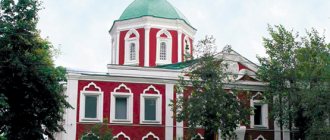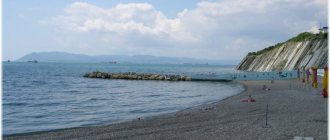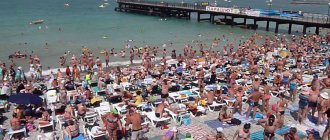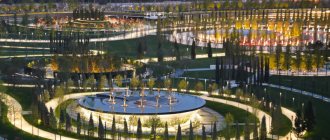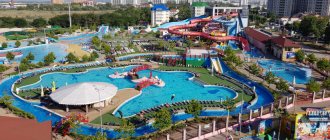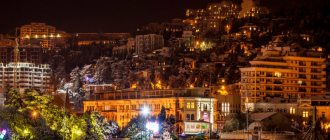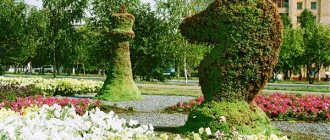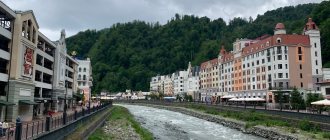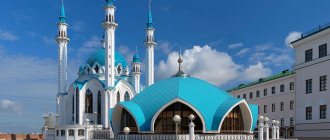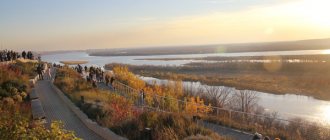Geography and climate
Sudak is located in the southeast of the Crimean Peninsula on the shore of the Black Sea bay of the same name. The city is located 76 km from Yalta and 48 km from Alushta. A ridge of low mountains stretches from the north, and from the east the Kapsel Valley and Cape Alchak approach.
Sudak has an arid Mediterranean climate, which is characterized by an abundance of sunny days. But at the same time, the city’s climate is somewhat colder than other Crimean resorts, which is especially felt in winter. Winter in Sudak can be quite cool, although severe frosts are rare.
Zander
Enterprises and work in Sudak
There have always been problems with work in Sudak. There are no large enterprises in the city. Many residents cannot find a permanent place of work. The main source of income for Sudak residents is the state farm, which produces a large assortment of dessert, table and dry wines.
SE "Sudak" Photo by 17Rising17
Most residents work during the tourist season. Cafes, bars, restaurants, hotels. In winter, their staff is reduced and people are left without work. Many residents rent out their apartments and houses to holidaymakers. The proceeds are enough to get through the winter comfortably.
Work can also be found in the markets. The central market, which operates all year round, provides jobs for 300-400 people. There is also a fruit market on Cypress Alley. It works for holidaymakers. Sudak residents sell homemade wine, oriental sweets, vegetables and fruits there. Prices in this market are much higher than in the central one.
There are also several supermarkets in Sudak: “ATB”, “Svityaz”, “Gyuzel”. Local residents also work on the beaches during the holiday season, selling various goodies. Trade in souvenirs is also in full swing on the cypress alley. There is a small clothing market nearby.
As a result, we can say that the majority of residents of the city of Sudak work in the summer and relax in the winter.
Vineyards
Story
Sudak is one of the oldest cities in Crimea. It was founded in 212 as a settlement of the Bosporan kingdom called Sugdeya. In the 7th century, the Byzantines settled here, built a port and founded a bishopric. At the beginning of the 13th century, Sudak became part of the Trebizond Empire, and a few decades later it was ravaged by the Seljuks.
In the second half of the 13th century, Venice tried to control the city, but during the first half of the 14th century it was ravaged by the Horde several times. Subsequently, Sudak was part of the Crimean ulus, which was controlled by the Golden Horde.
Panorama of the Genoese fortress
In 1365, Sudak was captured by Genoa. The Genoese ruled the city for 110 years. They restored and improved the ancient fortress, which is now the hallmark of the city, and built temples, wells and even a water supply system. In 1465, Sudak was conquered by the Ottoman Empire, within which it remained for more than two centuries and fell into decay.
In 1783, Sudak, like the whole of Crimea, became part of the Russian Empire. In the 18th century, the city practically ceased to exist and only a few dozen inhabitants lived here. Sudak began to develop again in the 19th century as a wine-making center. The status of a city was returned to it only in 1982.
How to get there from Simferopol?
There are several ways to get to Sudak from Simferopol Airport, the most popular being the bus. There is both direct communication between the cities and transit, when transport goes to Morskoye.
It will be faster to get to Sudak from the capital of Crimea by car, since in this case there will be no additional stops. The distance is about 110 km, which is about an hour and a half. On the map the route looks like this:
Crimean resorts are constantly in demand. Holidays in Sudak are not only about health treatments in sanatoriums and boarding houses. Today it means modern entertainment, interesting excursions to historical and natural attractions, unforgettable memories! At the end, watch a short overview video about this city.
Liked? Share with your friends!
How to get there
The nearest international airport and railway station are located in Simferopol. Buses and minibuses run from the capital of Crimea to Sudak. Anapa airport is also relatively close. A little further (about 385 km) is the larger Krasnodar International Airport. You can get from the Kuban capital to Sudak by bus.
Zander
Crime
In Sudak, high-profile crimes are very rarely committed. Mostly petty theft and drunken fights. For example, in February of this year, a guy in a hood snatched bags from women. There were three robberies, the criminal escaped and has not yet been found.
But still, there are several points that shocked local residents. Not long ago, a young man raped a pensioner. The criminal was behind bars.
The WWII veteran's awards were stolen, but law enforcement officers managed to return them.
Not long ago, a man was caught who ordered the murder of his wife 17 years ago. All this time he was hiding from law enforcement agencies, but was finally caught.
Attractions
Genoese fortress
Genoese fortress is the main attraction of Sudak, which is considered one of the symbols of Crimea. This powerful citadel was built in the late Middle Ages (14-15 centuries) by the Genoese and is perfectly preserved. Here you can see powerful battlements, barracks, twelve towers and several temples.
Fortress walls
The Sudak fortress begins at the foot of the Fortress Mountain (or in Tatar Dzhenevez-Kaya) and rises to its top. It is protected on all sides by natural barriers and is accessible only from the north. The fortress actually consisted of two parts: the outer perimeter of the walls with gates and a barbican, where the Lower City was located, as well as the citadel itself with the consul's castle and a watchtower at the very top. Outside the gates of the outer walls were the port suburbs.
The Consular Castle is the most important and well-preserved part of the Genoese fortress, located in the eastern part of the citadel. It is a separate fortification, consisting of a residential tower, called a donjon, and two other towers, which are connected by a fortress wall. On the lower tier of the donjon there was a cistern and weapons storage. On the second floor there is a room with a fireplace. The consul lived on the third floor. The castle has a small courtyard, which is limited from the north by a corner tower. In its southwestern part there is a hidden door, from which the descent to the sea begins.
Intercession Church
The Church of the Intercession was built at the beginning of the 19th century and has some features of Moorish architecture. In the first decades of Soviet power, the church was closed and the bell tower was dismantled. The bell tower and services in the temple were restored in the 90s of the 20th century.
New World
Novy Svet is a small village 5 km from Sudak, located in a beautiful bay. Its main attractions are
- The Golitsyn Trail is a picturesque path along the sea that leads to an ancient grotto, where there used to be a cave temple, and then elite princely wines were stored. Golitsyn even equipped a concert hall in it, in which, they say, Fyodor Chaliapin himself sang.
- The sparkling wine factory was founded in 1878 by Prince Lev Golitsyn. Sparkling wine at receptions and ceremonies of the Russian Emperor Nicholas II.
- Relict juniper grove
Church of the Twelve Apostles
The Church of the Twelve Apostles is a small medieval temple on the territory of the Genoese fortress, probably built in the 13th-15th centuries for the Greek community. Previously it was famous for its large fresco depicting the Last Supper. Unfortunately, the fresco was lost during World War II. Although over the course of many centuries the church was destroyed and damaged several times.
Temple of the Apostle Matthew
The Temple of the Apostle Matthew is a medieval building on the territory of the Genoese fortress with an interesting history. It is believed that this building was built by the Seljuks in the 13th century. Then the Greeks equipped it as an Orthodox church, and the Genoese - as a Catholic one. After Crimea was included in the Russian Empire, an Orthodox Church was established here. Nowadays there is a museum here.
Megan
Meganom is the largest cape of Crimea, the coastline of which is more than 15 km long. Meganom is translated from Greek as “large, spacious”. It is famous for its picturesque bay with clear sea, terraces, rocks and is a natural monument.
Blue Bay
Blue Bay is a secluded bay near Cape Kapchik (New World), which is famous for its clear sea with blue water and picturesque nature.
Other interesting places in Sudak:
- Alchak-Kaya is a natural reserve with picturesque rocks and clear sea.
- Mount Falcon is a small picturesque peak that was part of a coral reef millions of years ago.
- Aquapark.
- Cave monastery founded in the 8th century by monks from Chersonesos.
Zander
Video: Sudak
Basic moments
From the west, urban development is limited by Mount Fortress, on the top of which the famous fortress rises. The towers and walls of the ancient fort are among the oldest buildings preserved in Sudak. From the north, the city is closed by Mount Taraktash or “Stone Ridge”, and its eastern part abuts the protected Cape Alchak. Many people come to this cape for the wonderful seaside landscapes and an interesting natural monument - the through grotto of Aeolian Harp.
View of Sudak from the Genoese fortress
In the center of Sudak you can see the Intercession Church, built in the first half of the 19th century. Another popular tourist attraction is the famous Sudak water park, which is located in the southern resort part of the city.
Sudak embankment
International Knight Festival "Genoese Helmet"
Travelers come to Sudak for the wonderful mild climate, excellent beach holidays and warm sea. There are several good beaches covered with quartz sand along the coastline. The swimming season lasts 138-140 days, and the number of sunny hours is 2550 per year - this is more than in Yalta (2220).
The city has a well-developed tourism infrastructure. Many hotels, boarding houses and guest houses have been built here, so there are no problems with accommodation. Proposals from the private sector are especially popular. Holidays in Sudak apartments, rooms and cottages are cheaper than in large cities on the southern coast of Crimea.
Sudak has entertainment centers, museums, historical and natural attractions. The seaside town is small, so transport is not needed to get from one end to the other. You can also take walking tours around Sudak. In addition, local travel agencies offer everyone a lot of interesting excursions with visits to the most famous sights of the Crimean peninsula.
History of Sudak
A coastal settlement near a river flowing into the sea was founded by the Sughds in 212. This name was given to one of the tribes of the Adyghe group of peoples. In the Middle Ages, the Crimean city was called differently: the Italians called it “Soldaia”, and the Greeks called it “Sugdea”. The city expanded and grew due to the merchants who came here from Italy and Greece, as well as artisans who came to earn money.
In the 6th century, the Byzantine emperor Justinian I the Great decided to build fortifications on the Crimean coast. The city reached its greatest prosperity in the 12th-13th centuries, when the routes of the Great Silk Road passed by it. In the middle of the 14th century, Soldaya was captured by the Genoese, and in 1475 by the army of the Ottoman Empire. The period of Turkish rule had an unfavorable effect on the city. It fell into disrepair, and the number of people living here became smaller from year to year.
In 1783, Sudak, like other Crimean cities, became part of the Russian Empire. During the Great Patriotic War, this part of Crimea was subjected to German-Romanian occupation, and when peace came, Sudak began to develop as a health resort and winemaking center.
Medieval fort and museum
The Genoese fortress is located in the western part of the city, near the sea coast, on top of the Fortress Mountain. The fortifications rise noticeably above the city blocks and are therefore visible from afar - both from Sudak itself and from the sea.
The exact time of construction of the fortress is not known. Some historians believe that it appeared in Sudak in the 6th century by order of the ruler of the Byzantine Empire, Justinian I the Great. After the Byzantines, Crimea was taken over by the Genoese, who significantly rebuilt and strengthened the defensive structures.
These days, the majestic medieval fortress has become a popular tourist attraction. It covers an area of 30 hectares and is open to visitors every day: from May to September - from 8.00 to 19.00, and from October to April - from 9.00 to 17.00. Entrance to the territory is paid. You can explore the ancient fort on your own or with a guide.
The Genoese fortress has two lines of defense - external and internal. The outer line stretches along the northern slopes of Fortress Mountain and consists of 14 towers and the Main Gate. The towers in this area of defense are up to 15 m high, and the walls between them are 6-8 m, with a thickness of up to 2 meters. The internal line of defense includes 4 towers. At the very top of the Fortress Mountain stands the Watchtower, which is also called the Maiden Tower.
The ancient fortress houses a massive stone building known as the “arcade temple.” This iconic building has an interesting history. In the 13th century, the Seljuk Turks built the Padishah-Jami mosque in the Sudak fortress. When Turkish rule ended, the Muslim temple was converted into a Greek Orthodox church, and the Genoese who came to power used it as a temple for Catholic services.
In the 15th century, the Ottoman Turks settled on the peninsula, and they turned the religious building into a mosque. Time passed, Crimea became part of the Russian Empire, and an Orthodox church was again created here, consecrating it in honor of the Apostle Matthew. Approximately 600 years after its construction, in 1817 this church was closed due to disrepair. However, the story of the ancient temple did not end there. In the 80s of the 19th century it was restored and began to be used as an Armenian Catholic church.
Divine services here were interrupted in 1924, by decision of the city authorities. Two years later, a museum was opened in an ancient stone building, telling about the history of the city of Sudak and the Genoese fortress. This museum is located in the former temple today.
For several years now, in the middle of summer, a large-scale festival has been held in the ancient Genoese fortress - the colorful festival “Genoese Helmet”. It is attended by members of historical reconstruction clubs, fencers, as well as city residents and tourists who come to Sudak. During the festival, exciting knightly tournaments and a spectacular assault on the fortress take place. Master classes are held for guests, where you can learn pottery and blacksmithing, as well as try on knightly armor.
Astagvere Tower (Port) and the ancient Temple of the Twelve Apostles
The Tower of Astagvere and the Temple of the Twelve Apostles are located on a rocky hill to the west of the Genoese fort, 150 meters north of the seashore. Previously, a section of the fortress wall adjoined the Astagvera Tower, which connected it with the Corner Tower of the main fortification. The fortification was built in 1386 to protect the city port. The place was chosen well - between two rocky peaks. The tower was named after the commandant of Soldaya, Federico Astagwer.
On the masonry of the tower you can see many bas-relief slabs, on which crosses of different sizes are carved. Researchers believe that these are tombstones that the builders brought from a nearby cemetery. All walls, except the north one, are plastered. The three-story tower, closed on all sides, stands on a massive square foundation and has four tiers. Each wall has loopholes so that defenders can fire in any direction. In addition, at the very top of the tower there were battlements that provided protection for archers.
The ancient builders thought through everything to the smallest detail and made sure that the people defending the tower could stay in it for a long time. On both sides of the fortification, large containers were knocked out in the rocky ground and filled with water from a small mountain river, so medieval warriors were always provided with a sufficient supply of drinking water.
Near the tower of Astagvere, on a rocky hill stands the ancient temple of the Twelve Apostles. Soldaya was a trading city and grew from the coastal part. Near the city port there were houses of residents, merchant shops, craft workshops and outbuildings. During archaeological excavations in this part of Sudak, coins and ceramics of the 3rd-4th centuries were found.
In the 10th-12th centuries, a small stone basilica was built for the harbor residents. One pentagonal apse was made from hewn stone slabs in the church and the temple was consecrated in honor of the prophet Elijah.
The coastline looked different in those days. Over the past centuries, the water level in the Black Sea has risen by 3-4 m, rising sea water has swallowed up the coastline, and the old harbor is now located at the bottom of the sea. However, an ancient basilica with a gable roof was erected on a hill and remains to this day next to the majestic Port Tower.
It is known that before the Second World War, inside the temple one could see a wall image of Jesus Christ and his closest disciples gathered for the Last Supper - which is why the new name was assigned to the ancient church. It began to be called the Temple of the Twelve Apostles. It was restored in 2009, and now it is a functioning Orthodox church.
Temples in Sudak
The Church of the Intercession of the Virgin Mary rises in the center of Sudak, 0.65 km southeast of the bus station, on the street. Lenina, 27. This temple was founded in 1819 and began to be built with donations from townspeople. However, the money raised was not enough, construction dragged on and was completed only in the 1840s. The church, consecrated in honor of the Intercession of the Virgin Mary, is interesting as a place where members of the Russian imperial family visited several times.
Services in the temple took place until 1936, then, during the period of active anti-religious campaign, it was closed to believers, and the bell tower was destroyed. During the Nazi occupation, the church was reopened to parishioners. It received residents of Sudak until 1962, when the temple was closed again by decision of the authorities. The Palace of Pioneers began to operate inside the iconic building, and after it, repair shops. In the early 1990s, the old church was restored.
The cross-domed church has entrances on three sides. According to the architectural traditions of the mid-19th century, they are decorated with columns and triangular pediments. To the left and right of the doorway you can see beautiful mosaics depicting saints. Nowadays, the temple is operational and open as a courtyard of the Kiziltash monastery.
Another, more ancient temple - the Church of St. Paraskeva is located on the western outskirts of Sudak, on Primorskaya Street, 13. It is located in the center of the modern resort village of Uyutnoye, under the walls of the Genoese fortress.
Historians believe that the small church was built in the 10th-12th centuries. This is a one-story stone building with a gable roof covered with tiles. In former times there was a large cemetery around it, but today only two tombstones have survived from the old churchyard. One slab stands on the grave where members of the family of the scientist Christian Steven are buried, the same one thanks to whom the famous Nikitsky Botanical Garden was founded. The second tombstone covers the grave of the St. Petersburg artist Kondaraki.
Nowadays, the Paraskeva Pyatnitsa Church has been well restored, and services are regularly held there. Next to the Orthodox church you can see a one-story Lutheran church building. It appeared in Sudak at the end of the 19th century for members of the German colony, whose members began to settle under the Genoese fortress in 1805.
Museum "Funk's Dacha"
To the east of the Genoese fortress, in a beautiful two-story house that appeared in Sudak at the beginning of the 20th century, there is an interesting historical museum (Ushakova Street, 1). It got its name from the surname of the owner of the house - Fedor Fedorovich Funk, manager of the estate of K. A. Gorchakov.
Museum exhibits occupy four halls. The first of them exhibits archaeological finds dating back to Paleolithic times. At Funk's Dacha you can see objects from a Tauri settlement, a Gothic sanctuary, an Alan burial ground and an ancient Greek fort. The second and third halls of the museum are dedicated to the history of Sudak during the reign of the Byzantines, Khazars and Venetians. The last hall of the museum exhibition tells about the periods of the Principality of Theodoro and the Ottoman Empire. “Funk’s Dacha” is open to visitors every day, except Mondays, from 9.00 to 18.00.
Excursion to Cape Alchak-kaya
Cape Alchak-kaya limits the urban development of Sudak on the eastern side. Nowadays, this is a protected area, and travelers have to pay an entrance fee. A hill located on the seashore is all that remains of an ancient coral reef. Alchak-kaya received the status of a natural monument in 1988, and today it is protected by local forestry.
At the foot of the cape, where the small river Suuk-su flows into the Black Sea, archaeologists found a Bronze Age site, as well as coins minted in the 3rd century, when the Bosporan kingdom existed. A walking journey along the picturesque cape takes about one and a half hours. The tourist trail is surrounded by thickets of pistachio trees, barberries and prickly rose bushes.
From the top point of Alchak-kaya (152 m) a beautiful panorama of the sea coast opens. From here you can clearly see the Genoese fortress and the resort part of Sudak. On the slope facing the city, there is a through grotto of Aeolian Harp, which was formed in the rock as a result of centuries of erosion.
Water entertainment center
The Sudak water park, known to all Crimeans, is located in the southern part of the city, at the foot of Mount Alchak-Kaya, at the address: st. Gagarina, 79. Its territory is adjacent to the city embankment and is only a hundred meters away from the sea. The water park in Sudak is open during the summer tourist season, every day from 10.00 to 18.00.
For visitors, there are 6 swimming pools and 9 attraction slides, the height of which ranges from 10 to 14 m. The spacious pool has a three-level depth, fountains, a jacuzzi and a river with a counter-flow.
For young visitors to the water park, a separate pool has been created with a three-level depth, safe for swimming children from 2 years old. The children's pool has three slides, fountains and an entertainment sports complex in the shape of a ship. It is very important that the children's pool is equipped with autonomous water purification and disinfection systems.
Restaurants and cafes
Public catering is developed in Sudak, so there are many restaurants, cafes, canteens, snack bars and bars open in the city. In most of them the prices are approximately the same, only the establishments on the embankment sell at a noticeable markup.
During the summer tourist season, on the beaches of Sudak they sell boiled corn, waffle sticks with condensed milk, baklava, chak-chak, fresh raspberries, mulberries and peaches, smoked perch, manti, pilaf, as well as mashed potatoes with cutlets and salad.
There is a lot of fast food on Cypress Alley. Here travelers can buy chicken rolls, aromatic chir-chir pastries - the local analogue of cheburek - and triangular pies - samsa baked in a tandoor.
While relaxing in Sudak, you should try Crimean cuisine. Local culinary traditions have been formed for many centuries. Despite the fact that the peninsula is inhabited by representatives of more than 80 nationalities, the dishes of the Crimean Tatars give the local cuisine its original flavor. These are, first of all, meat treats: “kubete” - a pie filled with lamb, potatoes and onions; “Yufakhash” – small dumplings with lamb, which are usually eaten with the broth in which they were boiled; sarma - meat “stuffed cabbage rolls” wrapped in grape leaves, and, of course, Crimean lagman - a hearty, rich lamb soup with vegetables and special noodles.
No less tasty and varied are the dishes of traditional Karaite cuisine: “buber dolmasy” - peppers stuffed with vegetables, duck under dough, Karaite pies, meatballs with nuts and raisins, turkey with quince, as well as melon jam with dogwood.
In Sudak, it is worth trying fried Black Sea fish - red mullet, as well as dishes from flounder and mullet. Some restaurants in the city serve perfectly prepared mussels and rapana juliennes.
The taste of a Crimean holiday would be incomplete without aromatic jam made from rose petals, dogwood or quince. Sudak also sells excellent Crimean wines. Massandra wines are famous for their excellent quality and aroma. It is advisable to consume them chilled to +16 ºС. And tea lovers will certainly appreciate fragrant Crimean teas with mountain herbs.
Special offers on Sudak hotels
Booking.com
How to get there
The nearest airport to Sudak is located 107 km from the city, in Simferopol. Flights from Moscow and other major Russian cities are accepted here. Direct and passing regular buses run from the Simferopol bus station to Sudak several times a day. During the holiday season they start running from 5.30 and end at 20.30. Buses go frequently, every 20 minutes. The road to Sudak takes about two hours. In addition, if desired, you can take a taxi to the coast.
During the high season, people come to Sudak using a “Single Ticket” provided by Russian Railways. To do this, they travel by train to Krasnodar or Anapa, and then travel to Sudak by bus via the Port Kavkaz - Port Crimea ferry crossing.
From Sudak there are regular bus services to Feodosia, Sevastopol and the New World. In addition, many buses run daily from the city bus station connecting Sudak with the nearest resort suburbs.
Infrastructure: shops, markets and pharmacies
In Sudak, trade took place in two city markets:
- The Central Market is located at the beginning of Cypress Alley, where you can buy fresh fruits and vegetables, oriental spices, local pastries, river and sea fish and much more.
- The Cool market is located at the end of Cypress Alley. Here tourists have access to souvenirs, essential oils, Crimean teas and herbs. Sellers will also offer towels, summer linen clothes, swimsuits, postcards and magnets with city attractions.
In the city center and on the embankment there are shops where you can find everything your heart desires. If your four-legged tailed friend is traveling with you, if necessary, you can visit veterinary pharmacies and stores:
- "Aibolit", located on Lenin Street, building 38.
- “ZooMir”, located on Oktyabrskaya street, building 34.
Opening hours of establishments for our little brothers: daily from 9:00 to 17:00.
Crimean wine
The culture of the most famous Crimean grapes dates back more than one century. The official history of the wine industry began for Sudak in 1804, when a winemaking school was opened here. And the unofficial or prehistory is in 1783, from the moment of the annexation of Crimea and Sudak, including, to the Russian Empire. Sudak went to Prince Potemkin, who immediately decided to develop new lands, turning this region into a blooming garden. From words to deeds, the best varieties of vines were delivered from Europe to Sudak, hundreds of almond, mulberry, lemon trees, hazel and fig bushes were planted in the city and its environs. From the documents of the zemstvo government it is known that in 1787 in Sudak 31,846 buckets of wine and 300 buckets of cognac were produced, and in 1888 there were already 500,000 buckets of wine from grapes growing on 1,600 dessiatines of the vineyard. The wine quickly gained popularity and was produced mainly for other provinces and the capital.
Today Sudak is one of the largest wine-making centers of Crimea, known in Europe. There are 7 wineries and one essential oil plant operating here.
But we owe the appearance of domestic champagne to Prince L. S. Golitsyn. Having studied winemaking technology in France and the natural resources of Crimea, Golitsyn founded a small factory for the production of champagne wines on his estate in the village of Novy Svet. So in Sudak they began to produce first-class champagne and vintage wines, the best in Russia. In 1900, the World Industrial Exhibition was held in Paris, where world experts unanimously awarded the highest award, the Grand Prix, to Russian champagne “New World”. Unfortunately, the best taste that eclipsed French champagne has long since sunk into oblivion; its last batch was released in 1905. But Golitsyn’s case continues to live. Today Sudak is one of the largest wine-making centers of Crimea, known in Europe. There are 7 wineries and one essential oil plant operating here, which produce such unique vintage wines as “Sunny Valley”, “Black Doctor” and “Black Colonel”, “Kokur dessert Surozh” and “Bastardo Massandra”. For signature wines, you should go to.
What to bring
An obvious gift is a bottle of local wine or champagne. “Black Doctor”, “Surozh”, “Sunny Valley” have held the lead among Crimean wines for decades, and “New World” champagne is familiar to connoisseurs all over the world.
A large number of Crimean Tatars live in Sudak, many of whom are engaged in handicrafts. You can buy traditional products from them, such as whistles, bracelets, etc.
The main attraction of Sudak is the Genoese fortress. It is not surprising that local artisans offer a large selection of magnets and miniature models of this object.
Handmade soap made from natural Crimean products is popular: lavender, essential oils, propolis, juniper extracts, etc.
Where to stay
In the city itself, prices for hotels and inns are quite reasonable, but there are villages near Sudak, for example, the villages of Uyutnoye or Morskoye, where the cost of living can be found lower. You can also save money by coming on vacation during the low season or booking accommodation in advance, even in winter.
According to reviews from tourists, there are ideal places at adequate prices and with full service: in the guest house "Aquatel" or "Romania", in the hotel "Forum" or "Bastion", in the boarding houses "Azaria", "Zvezdny". The average cost of a double room per night is from 1000 rubles.
If you don’t save money and are looking for the best hotel for your holiday, Soldaya is the largest tourist complex in the city, located at the foot of the Genoese fortress.
Weather
The climate of Sudak has much in common with the climate of the western and central parts of the South Coast. However, due to the low altitude of the local mountains, the weather is significantly influenced by winds from the steppe part of Crimea. In this regard, the climate of Sudak is not subtropical, but is classified as continental marine.
Summer is hot and dry, the average daily temperature in July is +27-28°C, with temperatures often exceeding +30°C. The sea water temperature reaches +19°C by June, and +22-23°C in July. Thanks to the wide coastal strip of shallow water, during especially long periods of heat, the sea near the coast can warm up to +28°C, and sometimes even higher.
